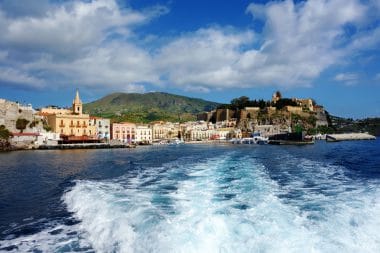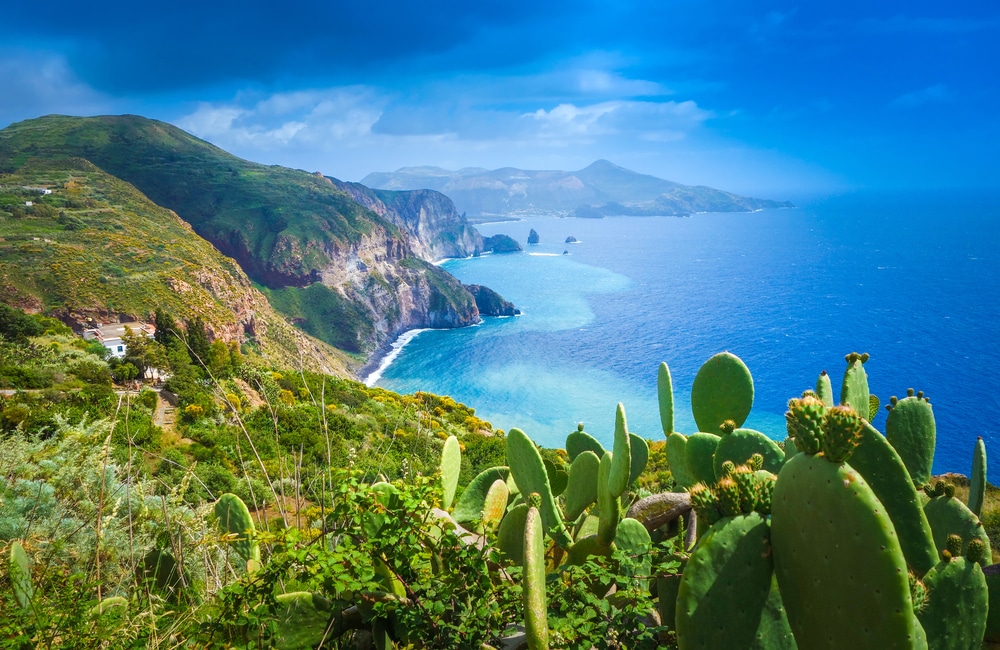Lipari, an island of volcanic origin north of Sicily at the level of the “metatarsal” of the Italian boot tip, belongs together with six other islands to the Aeolian Islands, more precisely to the Aeolian archipelago in the Tyrrhenian Sea. With its capital of the same name, Lipari is the largest, most populous and most attractive island in the archipelago.
The island itself combines both peace and liveliness on the foundation of a lively past. Lipari was once under the rule of many different Mediterranean powers: Greeks, Carthaginians, Romans, Arabs, Normans, Angevins, Aragonese and finally Sicilians or Italians. Today, tourists take over from time to time and from time to time.
Numerous accommodation options, great hospitality, culinary delights, green hills, crystal clear water, bright white pumice quarries, picturesque beaches, cafés, bars, restaurants and of course historical cultural sites await you on Lipari.
Round trip on Lipari
Lipari offers more than just sun, beach and sea. If you like, you can let the sun shine on your belly and enjoy the turquoise blue sea to the fullest, but for those who want to explore the island, there is a varied picture. With a length of about 9 kilometres and a maximum width of 7 kilometres, it is not impossible to conquer the entire island within one holiday on the beautiful panoramic road.
Starting from the town of Lipari, the route goes counterclockwise to the beautiful fishing village of Canneto, where many bathers cavort in the summer months. Continuing on, you will reach the historic pumice quarries, where at Porticello the white rock provides the ideal contrast to the turquoise blue sea. Here, too, (sun) bathing is the order of the day on the fantastic pebble beaches. Finally, in the north, you come to the small town called Acquacalda with its inviting lava stone beach.
The panoramic road leads further west into the interior of the island. If you like, you can now venture into higher realms, stretch your feet a little around Lipari’s highest elevation – the 602-metre-high Monte Chirica – or hike from Quattropiani to the 594-metre-high Monte Sant’Angelo.
We end our tour in the south and then return to the starting point.
La Dolce Vita in Lipari Town
Of course, Lipari town is not nearly as turbulent as on the Italian mainland, but life pulsates here as well. The fact that most holidaymakers arrive at the Marina Lungo harbour already makes for lively activity. In the old port of Marina Corta, on the other hand, fishing boats provide more idyll. The harbours are framed by bars, restaurants and cafés. Above the rooftops of Liparis, between the two ports, towers the city’s landmark: the fortress. Among other things, the Archaeological Museum with prehistoric ceramics can be found here.
Other sights include the Cathedral of San Bartolomeo, the small church on the pier and remnants of times long past. In general, you should let yourself drift through the city and enjoy the atmosphere.
Small but nice!

If you like it quieter and smaller, you can dedicate yourself to the small fishing village of Canneto, which is not home to any sights. It scores with small bays, turquoise blue sea, diving and swimming opportunities, as well as lava sand beaches and a picturesque view of Stromboli.
Between the towns of Canneto and Porticello there are other beautiful beaches, framed by the bright white pumice stone. The Spiaggia Bianca is said to be the most beautiful on the whole island.
Acquacalda – which translates as “hot water” – was famous in earlier times for its thermal springs, which no longer exist. Nowadays, the place, from where pumice stone was once shipped, doesn’t have much to offer except a sea-long beach and a view of the neighboring island of Salina.
If you are a lover of particularly beautiful views, you should not miss the Belvedere near Quattropiani. In particularly clear weather, you will be granted a view of the smoking Mount Etna.
Why Lipari?
Lipari is the insider tip within the Mediterranean region. Here you can find peace, entertainment, culture and mild temperatures in a relatively small area. Lipari is a bathing paradise with numerous beaches. Nature lovers get their money’s worth on hikes in partly untouched landscapes. Almond and olive trees, but also wine, as well as the white pumice cliffs and the turquoise blue sea, characterize the image of the island.


